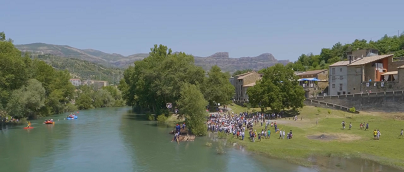
If you prefer to always view the website in English, please click here.
If you prefer to always view the website in English, please click here.
Within our bid for technological leadership to reduce CO2 emissions - compiled in the 2015 Sustainability Report - we have set up a variety of projects.
At Endesa, we have taken a good look at deep geological formations that are capable of capturing carbon dioxide and of preventing it from being released. We have set up the GEACO project (Geophysical techniques applied to geological CO2 storage characterisation in deep saline aquifers) to explore the deep saline aquifers located more than 800 metres below the surface as a potential geological CO2 storage.
This project, developed within the geographic field of research permits according to Law in force 40/2010 on Geological CO2 Storage in the provinces of Leon, Valladolid and Palencia, was set up with two key targets:
How do we do it?
We obtain and interpret data from Magnetotellurics (MT) and Electromagnetic Field Measurements in Time Domains – both geophysical exploration techniques. The results will improve underground exploration techniques and lower costs by reducing the number of exploratory probes.
The project has received public funding, provided through the CDTI with funds from EEA Grants, whose aim is to reduce economic and social disparities in the European Economic Area and also strengthen bilateral relations between Donor States (Norway, Iceland and Liechtenstein) and the 16 European Union states that benefit from this funding, including Spain.
The study of the capacity of microalgae to consume CO2 was the origin of a series of actions focussed on using them to capture greenhouse gas emissions.
At Endesa, we began working on the technology to fix CO2 with microalgae within the CENIT CO2 project, financed by the CDTI. We are building the largest national technology pilot plant in Europe, working with seawater and with CO2 released by the Litoral coal fired power station in Carboneras (Almería).
To follow up this technological development, a second phase of the pilot plant was built during the LESS CO2 project (using ERDF funds), intended to test new types of photobioreactors, as well as develop processes to assess the biomass obtained.
Between 2011 and 2014, we carried out activities within the EnerGetical project (funded through the Innpacto programme by the Ministry of Science and Innovation, then Ministry of the Economy and Competition with dossier no. IPT-2011-0842-920000), mainly to develop technology to produce microalgae for subsequent commercial purposes. This project studied laboratory genetic modification methods and optimised the processes involved in the operation and plant maintenance, managing to increase the microalgae biomass production capacity and its lipid and protein content. It also completed marketing studies, competition analysis and future marketing possibilities.
Today, the pilot microalgae plant sustains the production for its commercial activity and obtains components with a high added value in proteins, fatty acids, etc.
The scientific and technological knowledge gained from these projects is now being applied in the INNOVAALGA project -funded by the Andalusia Technology Corporation (CTA) with dossier number 14/775- to extract bioactive compounds from microalgae to produce bio-fertilisers.
Around eight tonnes of CO2 per day are captured at the foot of the Asturias mountains, in the small village of La Pereda. They are stored in the 1 MW experimental plant built by Endesa, Hunosa and the CSIC. By means of carbonation-decarbonation cycles and using lime as a sorbent, we have managed to increase efficiency by almost 90%.
At Endesa we are leading the reCal and CaO2 projects in an attempt to extend the La Pereda project, working with other companies and European research centres to improve the process for capturing CO2 using carbonation-calcination cycles.
The aim is to reduce the costs of capturing tonnes of CO2 by 30%, just cutting down the limestone consumption of in the process.
Both projects are subsidised by the RFCS European research programme and developed in the CO2 capturing pilot plant owned by Endesa, along with CSIC and HUNOSA, in the La Pereda power station.





